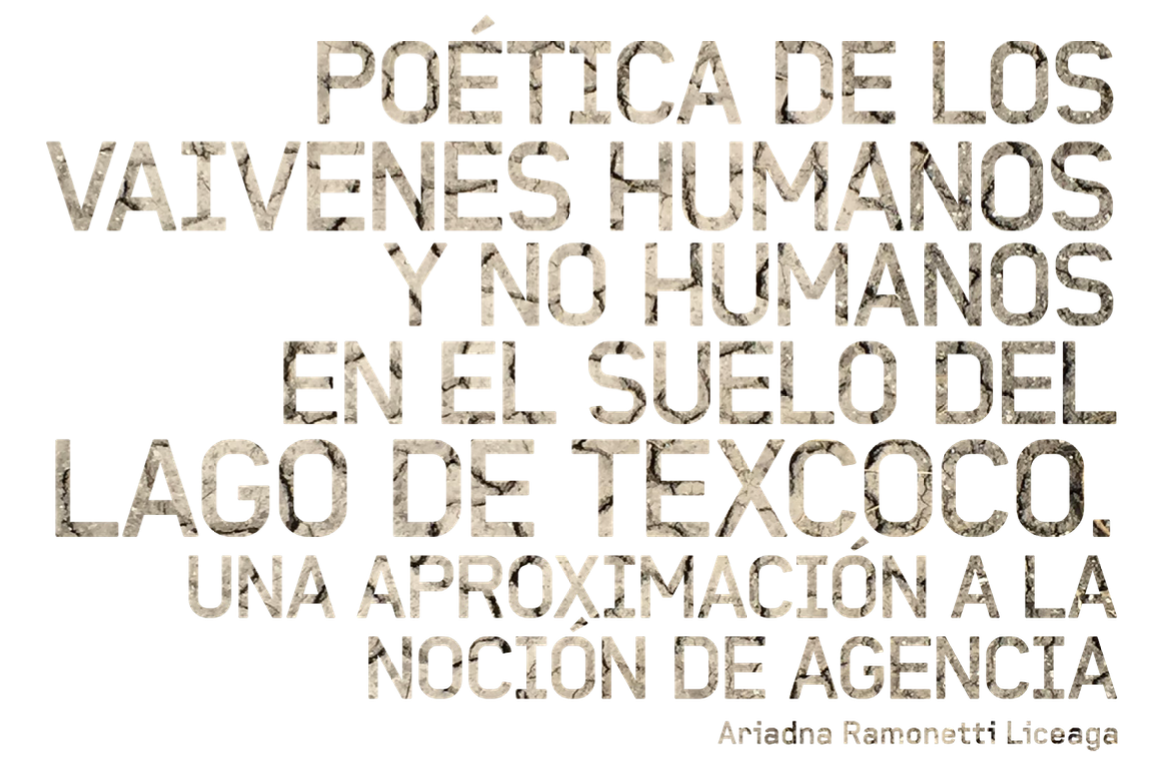Poetics of human and non-human displacements on the soil of Lake Texcoco. An approach to the notion of agency

Published 2022-12-15
Keywords
- Texcoco Lake,
- agency,
- geontopower,
- non human actor,
- Basin of Mexico
How to Cite
Copyright (c) 2022 Ariadna Ramonetti

This work is licensed under a Creative Commons Attribution-NonCommercial 4.0 International License.
Abstract
The idea behind this essay is to be able to think of Lake Texcoco -a large shallow wetland located northeast of Mexico City -as a non-human agent that overflows beyond the epistemological and cultural categories that define and designate it as a “lake.” I will use my own experience walking on its soil and also the reflections and provocations launched by various authors, such as Bruno Latour, Elizabeth Povinelli and María Puig de la Bellacasa, among others, to understand how this agent resisted the silencing implied by the construction of an airport in its bed that threatened the interspecies communities that still exist there, those who resisted due to Lake Texcoco’s changing and elusive nature along with the people of the Atenco region who organized themselves to defend it from government imposition, which had insisted (and failed) for twenty years on the construction of an airport on the Lake.
Downloads
References
- Candiani, V. S. (2014). Dreaming of dry land: environmental transformation in colonial Mexico City. Stanford University Press.
- Cruickshank García, G. (1998). Proyecto lago de Texcoco: rescate hidroecológico (No. 551.482 C7 1998).
- De La Bellacasa, M. P. (2017). Matters of care: Speculative ethics in more than human worlds (Vol. 41). U. of Minnesota Press.
- De La Bellacasa, M. (2019). Re-animating soils: Transforming human–soil affections through science, culture and community. The Sociological Review, 67(2), 391-407.
- DECRETO por el que se declara área natural protegida con el carácter de Área de Protección de Recursos Naturales, la zona conocida como Lago de Texcoco [Presidencia de la República] 22/03/2022. Diario Oficial de la Federación.
- Descola, P., y Pons, H. (2012). Más allá de naturaleza y cultura. Amorrortu.
- Gell, A. (1998). Art and agency: an anthropological theory. Clarendon Press.
- Latour, B. (2007). Reassembling the social: An introduction to actor-network-theory. Oup Oxford. Latour, B. (2008). Reensamblar lo social. Manantial.
- Legorreta Gutiérrez, J. (2006). El agua y la Ciudad de México: de Tenochtitlán a la megalópolis del siglo XXI. Universidad Autónoma Metropolitana.
- Parsons, J. R. (2001). The Last Saltmakers of Nexquipayac, Mexico: An Archaeological Ethnography (No. 92). University of Michigan Museum.
- Parsons, J. R. (2015). Los últimos salineros de Nexquipayac, México: Un estudio de etnografía arqueológica. El Colegio Mexiquense.
- Povinelli, E. A. (2016). Geontologies. Duke University Press.
- Ramonetti Liceaga, A. (2019). En la boca del agua, en la orilla del centro: territorio, agencia y polí- tica en la ribera nororiental del
- Lago de Texcoco [Tesis de Doctorado, Universidad Iberoame- ricana]
- Ruiz, O., y. (2020). Todo lo sólido (se desvanece en el aire): Extractivismo y necropaisaje en el noreste de México. Re-visiones, (10), 13.
- Sistema de Aguas de la Ciudad de México (2012). El gran reto del agua en la Ciudad de México. Pasado, presente y prospectivas de solución para una de las ciudades más complejas del mundo. https://agua.org.mx/wp-content/uploads/2013/02/El-gran-reto-del-agua-en- la-Ciudad-de-Mexico.pdf
- Tarrow, S. (1997). El poder en movimiento. Los movimientos sociales, la acción colectiva y la política. Alianza.
